Visited the old path (2006, 11/29)
Recorded by: Hsiao-rou
Since the National Frisbee Contest was on the 10th of next month, schoolmates of Frisbee team were staying at school in the afternoon to practice and there were only five of us left with three teachers. We met at the middle corridor at 12:30 and rode in two separate cars heading to our destination today – the Majia Village. We passed the Beiyeh Village and took a photo in front of the monument marking the 50th anniversary of village relocation. Teacher also taught us about the relocation history of the Beiye Tribe. Then we moved on through a very dangerous cliff path. Teacher said the road would be fixed by the end of the year. We all struggled to get the seats at the right side when we got on the cars since it was scary to sit at the left side and see the sight under the cliff.
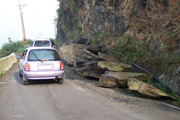
After passing through several little winding paths, we stopped at the welcoming stone of the Majia Village. Teacher told us that the old path we were to explore today was the main road to the Old Paiwan Village before the completion of Mafa Road, which started construction in 1988 and completed in 1989. It was a tiny path all the way to the Old Paiwan. The width was only good for an ox cart. Our car was driven in to get a sense, but the chassis of Teacher Hsu’s car was too low and it hit the bump on the road. So we had to move back. We watched Teacher Hsu moving the car back and forth for over twenty times before it turned its head. The car almost had to back up all the way back, then my teacher would definitely explode.

We also went to the field to ask old VuVu about the old path and experienced the pleasure of pulling out some pesticide-free Chinese cabbage. We left the old path and came to a big stone wall where we could clearly see the eastern hill of the Old Paiwan Village. Over here, teacher took out the compass and map to check and make sure the terrain in different directions. We also learned the usage of the map and compass. On the way back, we had some delicious stone-barbequed meat in front of the monument of the Majia Village. This was such a happy knowledge-seeking afternoon.
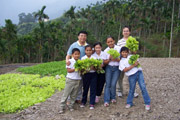
Fawan Elementary School Visit (2006, 12/06)
Recorded by: Hsiao-rou
It was again Wednesday afternoon - the time of exploration. Today we visited the abandoned Fawan Elementary School. The school was moved from the Old Paiwan Village in 1976 following the relocation of villagers to the new Fawan Village. Fawan Village was renamed Paiwan Village in 1986, but the school was still called Fawan Elementary School. In 1992, Fawan Elementary School merged with the Jiayi Elementary School next door and its original school area was abandoned and gradually forgotten by people.
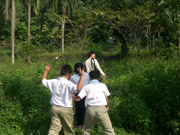 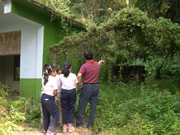
Fawan Elementary School was located at the most northern end of the Paiwan Village. The campus was in long shape, divided into two areas of classrooms and sports field. The words “Fawan” in the school’s name on the pillar of the entrance was gone covered with slates two years ago for the appearance construction project in the tribe. The former section of the school was decorated in bamboos to become tribal classrooms, but this was only for a short period of time. Now it was buried in weeds. Director Tsai led the visit today. He ever taught in the school in 1991 for one year. He told stories all the way from the entrance to classrooms and funny things about four of his students in the class. Two of them were still in the tribe. We saw a lonely statue of Confucius in the campus and jackfruit tree that was about to bear fruits. We jumped through the weeds. Our pants were stuck with seeds of the Railway Beggarticks Herb and spider webs. Those spiders must hate these uninvited guests very much to disturb their quiet lives. We retreated from the school to end this visit under the attack of numerous mosquitoes. Even though our faces and hands covered with swelling mosquito bites, we thought it very worthwhile to know all these past things.
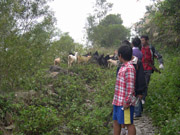 
Visited the stone quarry (2006, 12/13)
Recorded by: Hsiao-ning
Visiting had become a habit of ours for over three months. I felt somewhat odd if we didn’t go out on the Wednesday afternoon. This afternoon, we visited the stone quarry in the Paiwan Village. On our way to the tribe, we checked with VuVu again to make sure that the big stone wall we passed was not the quarry but used to be a playground for kids. Kids might climb to the top and slipped down by riding on leaves. But now it became steep because the bottom part was removed due to road construction and nobody played on it any more.
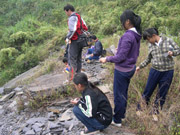
Today this was our fourth time to come to the Old Paiwan Village. From the scary first time and feeling the far distance till now, I felt this was such a wonderful place with wide open field and fresh air. We rode in two separate cars. After a spinning one-hour ride, we arrived at the Old Paiwan Village. It was a foggy day, but we felt something special to see the head of the North Dawu Mountain appearing above the clouds. Teacher told us that today we would visit the tucunu tribe and the relics of the 1907 Fawan police station and the 1931 education institute for aboriginal children. Those were all relocated to the Old Paiwan Village in 1933 when landslide happened and villagers moved to the Liangshan Village the next year in 1934. We started off from roads to little weed-buried trails, passed through the road to the Kapaiwan logging site and met with a flock of sheep. The tucunu tribe was not far ahead. Teacher struggled to cut open a path on the slope of the sports field. We saw many abandoned slate houses scattering in the bushes with only two stone walls left. We walked farther forward and there was the place where landslide happened. We climbed up and down on all fours. Masilid was the place where wild sunflowers grew everywhere and Uncle A-de told us that he saw the entire hill sliding down the valley in 1970 with his own eyes. We walked forward and arrived at the quarry. It was divided into two parts, the upper part on the roadside and the other part further down. We took a rest here and everyone picked a small stone piece for memory. On our way back, we moved rather slowly on the ascending road. We chased and had fun and completed our visit today safely and happily.
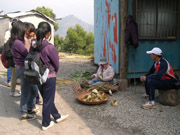
Visited the small tribe (2006, 01/03)
Recorded by: Hsiao-rong
According to the tribe map drawn in 1963, the Paiwan small tribe Tusantaf only stayed up to the relics of the Fawan Elementary School, but Uncle A-de said there were still many relics of slate houses in the bushes above the relics of the Fawan Elementary School. This was what we wanted to find out today.
We met at 12:30 after school. Eleven of us rode separately in cars of Director Tsai and Director Shih. On our way, Beiyeh villagers who blocked the Baibing Mountain stopped us and then let us go, knowing that we were heading to the Old Paiwan. The police even called us “little girls.” As we moved on, one more place was under repairing. Two power shovels were working with loud noises. That was scary. When we reached our destination, eighty minutes were gone already. We first spotted a VuVu who was handling laurel cherry stalks with hands without any other tools. He used thumb to split the stalk and bent it backward to become weaving materials in rolls. After dried up, they could be made into sifters to put things in, an economic and environmental protective way. Teacher also told us that the VuVu was the only spiritualist left in the Paiwan Village.
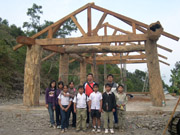 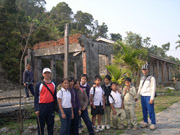
We followed teacher to the relics of the Fawan Elementary School. Beside the old classrooms, a construction was under way. Many lumbers transported from the mountain foot were cut into slices and sticks waiting to be put in place. The Paiwan Art Museum beside was almost finished. A few months later, its roof would be covered with slates and a primitive exhibition hall would be opened to present the past history and some items of the Paiwan Village. This would increase the attraction of the Old Paiwan, but teacher said this might damage the relics of Paiwan slate houses even more seriously. So how to manage between relics conservation and tourism expansion to increase villagers’ income will have to rely on the wisdom of village people and the authorities.

The tribe above the relics of the Fawan Elementary School was our second target. We searched in the bushes for a long time and “seemingly” found a path. Director Shih led us to climb upward and teacher helped pull us up. Some time later, we saw stone-built walls. We were sure that they had been occupied, but since teacher didn’t bring a knife to cut the weeds, we could not go any further. We had made an appointment to come back again next time well prepared with equipment. We slid all the way down the hill. When we reached the ground, the first thing we did was to pull out the thorns stuck in our delicate hands. (Note: After checking with elders later, we found that the Tusantaf should have been staying at the upper part, but some people followed their chief and moved to Kaohsiung County and Taoyuan County after the restoration and rest of the people moved to the tribe. Eventually this area was abandoned.)
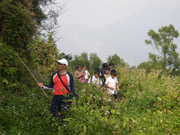
Then we were heading to the Old Pinghe for collecting slates. We passed through an extent of stone walls as soon as we were out of the Old Paiwan. The stone walls were huge, from the mountain top to the valley. Local people called them “swimming pools” because people could slide down from the top following the water in raining days. Maybe it’s better to call them “water slides.” Teacher also taught us how to distinguish slate and plate. We climbed up and down the stone walls trying to find proper slates and everyone collected a full load in plastic bags. Director Shih brought two students to explore the paths leading to the Old Pinghe, but that would be the trip for next time. We headed back when the sun was about to fall. We were blocked for half an hour at the road-repairing area. Every student was so tired and fell to sleep, quite different from the excitement at the beginning of the trip. At the Beiyeh Village, we separated by changing cars. Teacher sent me home before dark. Watching teacher returning home, I could not help but say, “Thank you for your hard
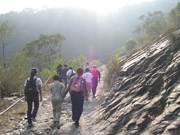
Top |
